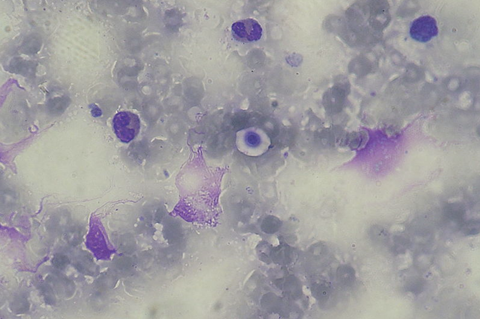Human skin, hair and nails are all vulnerable to fungal infections. While these infections are usually not serious, they’re difficult to fully resolve and often recur after treatment—sometimes for years. They’re also often resistant to treatments, including a common class of antifungals called azoles.

A study published this week in mSphere points to a new way to boost the efficacy of azoles in treating those infections—combining them with commonly available drugs called bisphosphonates, usually used to treat osteoporosis. Previous work by the same research group has shown that adding bisphosphonates to azoles can effectively treat yeast infections from Candida and Cryptococcus species. The new study extends that finding to dermatophytes, which cause superficial infections.
The study suggests that bisphosphonates could be repurposed to use with azole antifungals, which are relatively nontoxic, and that the combination could be readily tested in clinical studies.
Fungus will always develop resistance
“There aren’t many good antifungal drugs around, and the fungus will always develop resistance no matter how you treat them,” said senior author Dee Carter, a mycologist at the University of New South Wales, Australia. “For what we’re proposing, to use two drugs at the same time, that resistance is much less likely.”
Carter says she was only a little surprised to see the synergistic effect in dermatophytes. This research project began years ago, she says, when her group conducted a series of genomic analyses on the response of pathogenic yeasts to drug treatment. That study led them to a genetic pathway that is ’upstream’ of the pathway targeted by azoles, and is instead targeted by bisphosphonates. “That’s often a good way to get drugs to work, is to target processes that are interlinked like that,” Carter said.
Winning combination
In the lab, Carter and her team tested 3 commonly available bisphosphonates (risedronate, alendronate and zoledronate) in combination with 3 commonly available azole antifungals (fluconazole, itraconazole and ketoconazole). They tested these against clinical isolates from a diverse range of dermatophyte species that cause superficial infections. The combination of zoledronate and ketoconazole proved particularly effective against 8 of the 9 tested species. It also prevented the development of resistance.
Aidan Kane, mycologist, lead author of the study and a Ph.D. student in Carter’s lab, used fluorescence microscopy and other methods to show that the drug combination worked by weakening the cell membrane enough that the fungus could not survive. Beyond the dermatophytes, the group also found that bisphosphonate-azole combinations could act against molds that cause invasive disease, suggesting another possible clinical application for the drugs.
“You can use these combinations directly for superficial infections, like Candida or dermatophyte infections, and we’re hoping that with modified forms of the drugs we can create something that will also work systematically,” Carter said. “The next step is to continue testing bisphosphonate-azole combinations in animal models, and then test it in clinical trials.”
Supporting documents
Click link to download and view these files798px-Cryptococcus_smear_MGG_2010-01-27
Other, FileSizeText 64.1 kb798px-Cryptococcus_smear_MGG_2010-01-27 (1)
Other, FileSizeText 64.1 kb







No comments yet